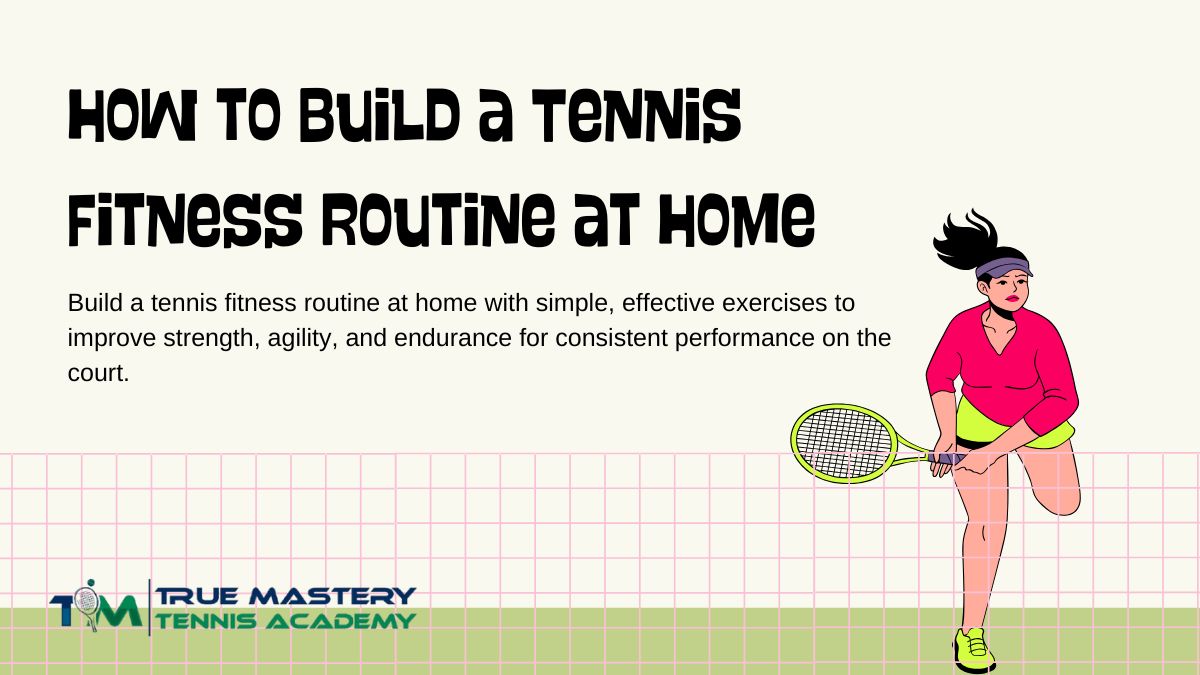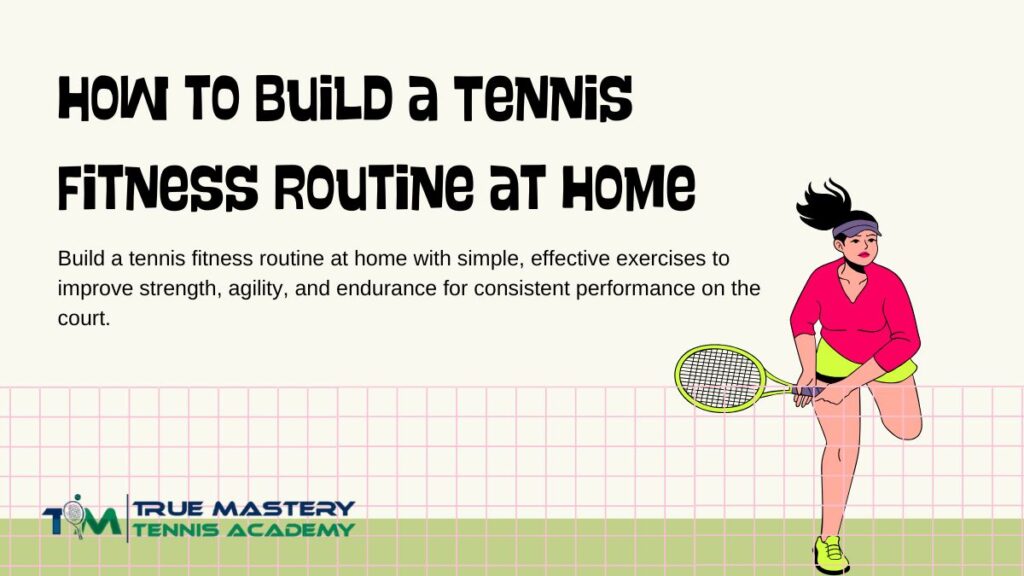How to Build a Tennis Fitness Routine at Home
A strong tennis game starts long before you step onto the court. Physical conditioning, agility, and endurance all play critical roles in determining your consistency, speed, and power. The great news is that you don’t need fancy gyms or expensive equipment to get match-ready. With a well-structured home tennis fitness routine, you can develop the strength, stamina, and coordination necessary to elevate your game while staying within budget and time constraints.
Understanding the Importance of a Tennis Fitness Routine
Tennis demands a combination of aerobic fitness, explosive power, lateral movement, and core stability. Without proper conditioning, even the most technically skilled player can struggle with fatigue, delayed reactions, and inconsistent shot execution. True Master Tennis Academy emphasizes the holistic development of players, combining court drills with fitness routines that enhance endurance, agility, and mental sharpness. A structured home fitness program can help players build these qualities systematically while reducing the risk of injury.
Warm-Up and Mobility Exercises
Every fitness routine begins with a proper warm-up. At home, dynamic stretches such as arm circles, torso twists, lunges, and high knees increase blood flow and prepare muscles for explosive movements. Incorporating mobility exercises, including ankle circles, hip rotations, and shoulder stretches, ensures joints are ready for the lateral and rotational movements typical in tennis. Consistently dedicating 10–15 minutes to warm-up routines can drastically improve performance and reduce the likelihood of strains during matches or practice sessions.

Cardiovascular Conditioning for Tennis
Tennis is a sport that requires quick bursts of speed, repeated sprints, and sustained movement over potentially long matches. Simple at-home cardio exercises, such as jumping jacks, running in place, skipping rope, or shuttle runs in a hallway or backyard, can significantly boost aerobic and anaerobic endurance. Interval training, alternating high-intensity bursts with short recovery periods, mirrors the stop-and-go nature of tennis rallies. Studies suggest that incorporating high-intensity interval training (HIIT) improves court endurance and overall cardiovascular fitness, which translates directly to better performance during matches (American College of Sports Medicine).
Strength Training Without Equipment
Strength is crucial for explosive serves, quick direction changes, and sustained rallies. Bodyweight exercises like push-ups, squats, lunges, planks, and glute bridges are highly effective for building strength at home. Core exercises such as bicycle crunches, Russian twists, and mountain climbers enhance rotational power, improving stroke execution. True Master Tennis Academy encourages players to combine upper-body, lower-body, and core exercises into a single circuit to maintain balanced strength and prevent muscular imbalances, which can lead to injury.
Agility and Footwork Drills at Home
Footwork is the foundation of consistent tennis performance. Quick lateral movements, forward sprints, and backward shuffles are essential. At home, you can set up a simple agility ladder using tape on the floor or cones to practice side-to-side movements, in-and-out footwork, and multi-directional patterns. Shadow tennis, simulating court movements without a ball, allows players to focus on proper foot placement, weight transfer, and movement efficiency. Consistent practice of these drills improves reaction time, positioning, and overall court coverage.
Plyometrics for Explosive Power
Plyometric exercises enhance explosive strength, crucial for powerful serves, volleys, and sudden directional changes. At-home plyometric routines include jump squats, box jumps using a sturdy step or platform, lunge jumps, and lateral hops. These exercises train fast-twitch muscle fibers, helping players react quickly and generate power efficiently. Research indicates that plyometric training can significantly improve serve speed and stroke power for tennis players (Journal of Strength and Conditioning Research).
Flexibility and Recovery
Flexibility plays a vital role in preventing injuries and maintaining a full range of motion for tennis strokes. Incorporate static stretches post-workout, focusing on shoulders, hips, hamstrings, calves, and back muscles. Foam rolling or self-myofascial release techniques help alleviate muscle tightness and improve recovery. True Master Tennis Academy emphasizes that regular stretching and recovery routines are essential, allowing players to sustain high performance across multiple training sessions or matches without overuse injuries.
Structuring a Weekly Home Tennis Fitness Routine
A balanced weekly schedule can ensure steady improvement without burnout. A sample routine could include three cardio sessions, three strength and plyometric sessions, and two agility-focused footwork practices. Flexibility and recovery should be incorporated daily, particularly after strength or intense cardio workouts. Rotating exercises and adjusting intensity ensures that muscles are challenged while minimizing fatigue and overuse injuries. Consistency in practice, combined with progressive difficulty, is key to achieving tangible results.
Incorporating Tennis Skills with Fitness
Physical conditioning should complement court skills. Pair home fitness routines with shadow drills, wall rallies, or ball-feeding exercises to integrate movement patterns with stroke execution. Practicing proper footwork and core engagement during these exercises ensures that strength and agility gains translate seamlessly to improved consistency and performance on the court. True Master Tennis Academy integrates fitness and skill development in its programs, helping players develop a holistic understanding of how physical conditioning directly impacts gameplay.
Case Study Reference
A recent study in Singapore involving youth tennis players highlighted that combining at-home fitness routines with on-court drills significantly improved serve accuracy, rally consistency, and agility over a three-month period (Singapore Sports Institute). Another international study demonstrated that home-based plyometric and agility exercises enhanced stroke power and reaction time without requiring gym equipment. These findings confirm that structured home fitness programs are not only cost-effective but also highly beneficial for tennis performance.
Conclusion
Building a tennis fitness routine at home is entirely achievable with dedication, structured exercises, and a clear understanding of the physical demands of tennis. By combining warm-ups, cardiovascular conditioning, strength training, agility drills, plyometrics, and flexibility work, players can improve their endurance, power, and court performance without expensive equipment or memberships. True Master Tennis Academy encourages players to integrate these routines into their weekly schedules, ensuring that fitness gains translate directly to consistency, speed, and skill on the court.
For more guidance on combining fitness with practical tennis skills, explore our tennis programs and lessons to get structured plans that suit your personal goals and schedule.
Click on the link to find out more about TM Tennis Academy’s lesson package. Chat with our head coach today!
About TM Tennis Academy
Private Tennis Lessons
Kids Tennis Lesson
Group Tennis Lessons
Whatsapp Us




